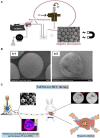Recent Advances on Polymeric Beads or Hydrogels as Embolization Agents for Improved Transcatheter Arterial Chemoembolization (TACE)
- PMID: 31231636
- PMCID: PMC6560223
- DOI: 10.3389/fchem.2019.00408
Recent Advances on Polymeric Beads or Hydrogels as Embolization Agents for Improved Transcatheter Arterial Chemoembolization (TACE)
Abstract
Transcatheter arterial chemoembolization (TACE), aiming to block the hepatic artery for inhibiting tumor blood supply, became a popular therapy for hepatocellular carcinoma (HCC) patients. Traditional TACE formulation of anticancer drug emulsion in ethiodized oil (i.e., Lipiodol®) and gelatin sponge (i.e., Gelfoam®) had drawbacks on patient tolerance and resulted in undesired systemic toxicity, which were both significantly improved by polymeric beads, microparticles, or hydrogels by taking advantage of the elegant design of biocompatible or biodegradable polymers, especially amphiphilic polymers or polymers with both hydrophilic and hydrophobic chains, which could self-assemble into proposed microspheres or hydrogels. In this review, we aimed to summarize recent advances on polymeric embolization beads or hydrogels as TACE agents, with emphasis on their material basis of polymer architectures, which are important but have not yet been comprehensively summarized.
Keywords: TACE; cancer therapy; drug delivery; hydrogel; polymeric beads.
Figures






Similar articles
-
Sulfamethazine-based pH-sensitive hydrogels with potential application for transcatheter arterial chemoembolization therapy.Acta Biomater. 2016 Sep 1;41:253-63. doi: 10.1016/j.actbio.2016.05.018. Epub 2016 May 13. Acta Biomater. 2016. PMID: 27184404
-
Idarubicin-loaded biodegradable microspheres enhance sensitivity to anti-PD1 immunotherapy in transcatheter arterial chemoembolization of hepatocellular carcinoma.Acta Biomater. 2023 Feb;157:337-351. doi: 10.1016/j.actbio.2022.12.004. Epub 2022 Dec 10. Acta Biomater. 2023. PMID: 36509402
-
Balloon-occluded transcatheter arterial chemoembolization for hepatocellular carcinoma.World J Hepatol. 2018 Jul 27;10(7):485-495. doi: 10.4254/wjh.v10.i7.485. World J Hepatol. 2018. PMID: 30079135 Free PMC article. Review.
-
Five-year outcome of conventional and drug-eluting transcatheter arterial chemoembolization in patients with hepatocellular carcinoma.BMC Gastroenterol. 2018 Aug 3;18(1):124. doi: 10.1186/s12876-018-0848-1. BMC Gastroenterol. 2018. PMID: 30075752 Free PMC article.
-
Treatment of Liver Tumors with Lipiodol TACE: Technical Recommendations from Experts Opinion.Cardiovasc Intervent Radiol. 2016 Mar;39(3):334-43. doi: 10.1007/s00270-015-1208-y. Epub 2015 Sep 21. Cardiovasc Intervent Radiol. 2016. PMID: 26390875 Review.
Cited by
-
Functional hydrogels for hepatocellular carcinoma: therapy, imaging, and in vitro model.J Nanobiotechnology. 2024 Jul 1;22(1):381. doi: 10.1186/s12951-024-02547-9. J Nanobiotechnology. 2024. PMID: 38951911 Free PMC article. Review.
-
Minimally Invasive Treatment Options for Hepatic Uveal Melanoma Metastases.Diagnostics (Basel). 2023 May 24;13(11):1836. doi: 10.3390/diagnostics13111836. Diagnostics (Basel). 2023. PMID: 37296688 Free PMC article. Review.
-
Recent advances and applications of microspheres and nanoparticles in transarterial chemoembolization for hepatocellular carcinoma.Wiley Interdiscip Rev Nanomed Nanobiotechnol. 2022 Mar;14(2):e1749. doi: 10.1002/wnan.1749. Epub 2021 Aug 17. Wiley Interdiscip Rev Nanomed Nanobiotechnol. 2022. PMID: 34405552 Free PMC article. Review.
-
A rat model for acute limb ischemia using microsized gelatin beads.Sci Prog. 2024 Jan-Mar;107(1):368504241231656. doi: 10.1177/00368504241231656. Sci Prog. 2024. PMID: 38490165 Free PMC article.
-
Efficacy and safety of transcatheter arterial chemoembolization combined with sorafenib and sintilimab in the treatment of unresectable hepatocellular carcinoma.Am J Transl Res. 2024 Dec 15;16(12):7849-7858. doi: 10.62347/KNIV1276. eCollection 2024. Am J Transl Res. 2024. PMID: 39822508 Free PMC article.
References
-
- Aliberti C., Carandina R., Lonardi S., Dadduzio V., Vitale A., Gringeri E., et al. . (2017). Transarterial chemoembolization with small drug-eluting beads in patients with hepatocellular carcinoma: experience from a cohort of 421 patients at an Italian center. J. Vasc. Interv. Radiol. 28, 1495–1502. 10.1016/j.jvir.2017.07.020 - DOI - PubMed
-
- Burrel M., Reig M., Forner A., Barrufet M., de Lope C. R., Tremosini S., et al. . (2012). Survival of Patients with hepatocellular carcinoma treated by transarterial chemoembolisation (TACE) using drug eluting beads: implications for clinical practice and trial design. J. Hepatol. 56, 1330–1335. 10.1016/j.jhep.2012.01.008 - DOI - PubMed
Publication types
LinkOut - more resources
Full Text Sources
Miscellaneous

